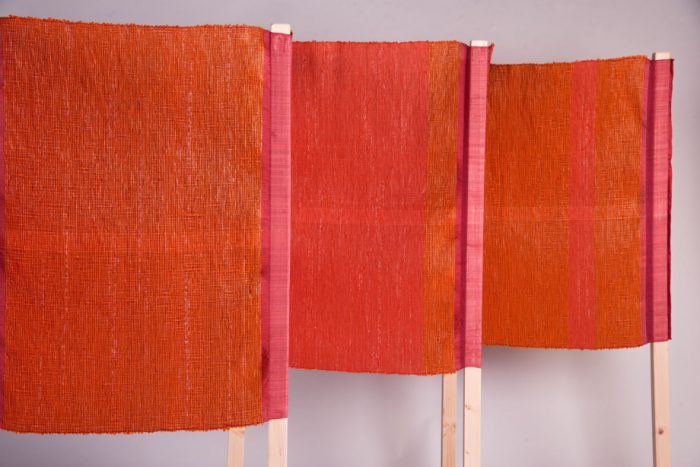“The advice I would give to myself is to keep an open mind to be able to adapt to different circumstances while making the most of the opportunities available during the degree.”
Please tell us a bit about your work and your influences
Using waste materials to create abstract designs that embody a greater concept or issue has been a way of working I have felt drawn to during my time studying. All aspects of my designs come from research and context development to ensure there is intention behind every decision. This final project was approached in this way.
I started my research with microplastics and how they are released from synthetic textiles often used in our interiors and clothing. My initial intention was to raise awareness of microplastics as a long-term environmental issue and from this investigate alternative ways of using waste plastics in textiles. During the early development stages of this research, I started pondering the possibilities of collecting airborne microplastics from our interiors. With the help of the University Science Department, I was able to confirm that my initial theory using static charge inherent in the plastic material would make collecting airborne microplastics possible. By combining science, architecture, and design I can use natural forces to collect microplastics on the surface of my textiles.
I used the research gathered to inform the textile designs for my final installation pieces. The design, colour and use of transparency was influenced by the works of Jessica Den Hartog, Do Ho Suh and Gerrit Rietveld.
How have you found your course and what made you choose it?
I was drawn to the 3D Design and Craft course because of the craft element which encourages sustainable practices. The Plastics and Polymers department was the main reason I chose the course as I wanted to explore working with waste plastic materials further. The structure of the course enables each student to experience all material areas which I found to be an enjoyable and enriching experience.
Did you go on a placement or ? If so could you tell us about it – what were your takeaways?
My course did not include a placement however I worked with a manufacturing company during my design projects and had the opportunity of work experience at an architect/interior design practice.
Was the location of your course in Brighton more important than you thought it would be?
With my interest in sustainable design practices developing during my time on this course, I have found Brighton an inspiring place to be.
What are your plans after graduation?
Following my degree show and exhibiting at New Designers in London this July, I am hoping for a year working in the sustainable design industry before attending a masters in textile design.
If you could give you 16 year old self any advice about going to University what would it be?
I attended a foundation course before university which prepared me and allowed me to make the most of my degree. Attending university during a pandemic was an unexpected turn of events which taught me how to work through difficult circumstances as a maker. The advice I would give to myself is to keep an open mind so I am able to adapt to different circumstances while making the most of the opportunities available during the degree.
Find out more about 3D Design and Craft

